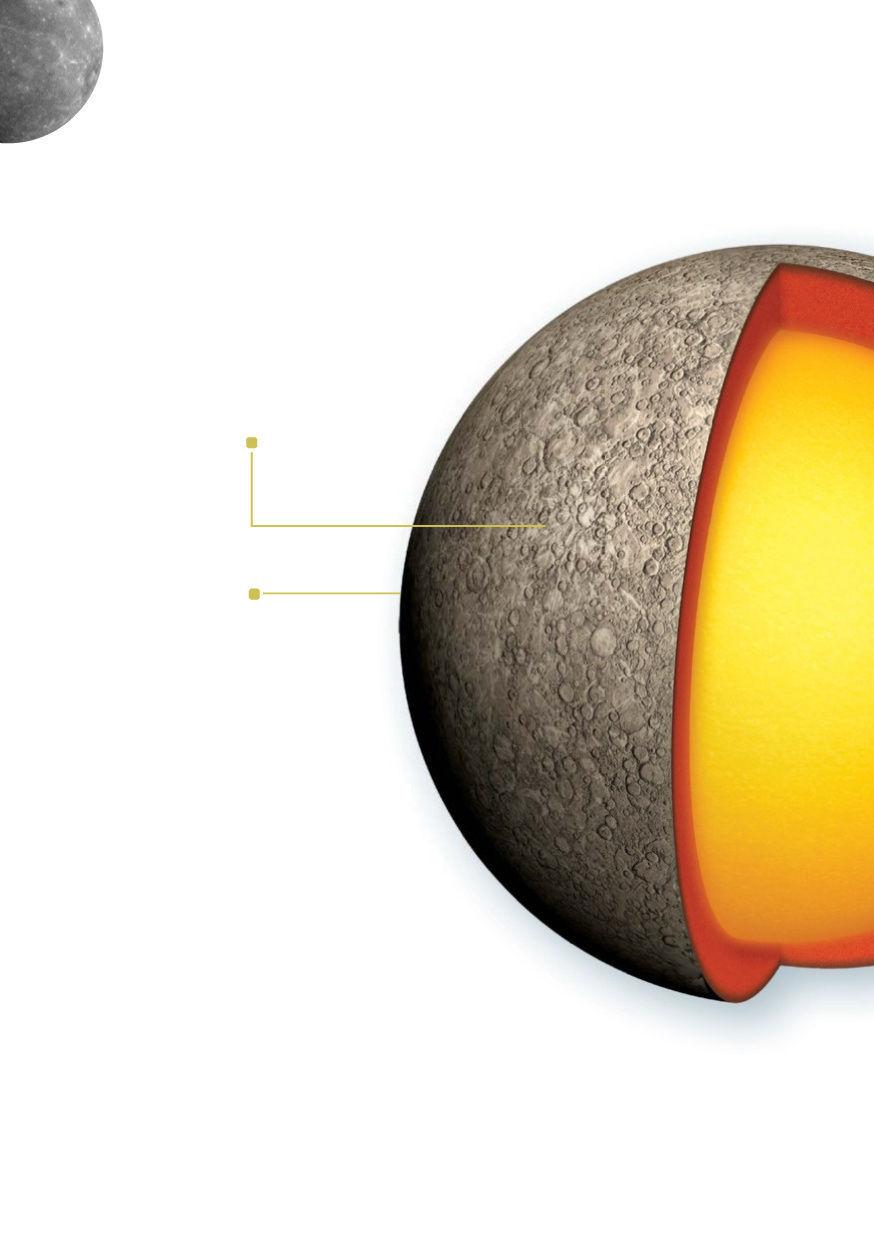
11 minute read
Mercury
from Oldie
by maurice.2008
Mercury has a huge core and a high concentration of core iron Mercury inside and out
The structure of Mercury
Advertisement
Huge impact As the mantle is so thin, there may have been an impact that stripped away some of the original mantle
Bombardment The crust may have formed after the bombardment, followed by volcanic activity that resulted in lava flows
Mercury contains about 30 per cent silicate materials and 70 per cent metals. Although it’s so small, this make-up also means that it’s incredibly dense at 5.427 grams per cubic centimetre, only a little bit less than the Earth’s mean density. The Earth’s density is due to gravitational compression, but Mercury has such a weak gravitational field in comparison to the Earth’s. That’s why scientists have decided that its density must be due to a large, iron-rich core. Mercury has a higher concentration of iron in its core than any other major planet in the Solar System. Some believe that this huge core is due to what was going on with the Sun while Mercury was forming. If Mercury formed before the energy output from the Sun stabilised, it may have had twice the mass that it does now. Then when the Sun contracted and stabilised, massive temperature fluctuations vaporised some of the planet’s crust and mantle rock. Or a thinner mantle and crust may have always existed due to drag on the solar nebula (the Sun’s cloud of dust
and gas from which the planets formed) from the close proximity to the Sun itself. Our latest information from the Messenger spacecraft supports the latter theory, because it has found high levels of materials like potassium on the surface, which would have been vaporised at the extremely high temperatures needed for the former theory.
Molten layers The iron-rich core has molten layers around a solid centre

Crust 100 to 300km thick, the crust solidified before the core did, part of the reason it’s covered in ridges
Mantle The mantle is made of silicate minerals and is 600km thick
Core With a 1,800km (1,118 mi) radius, Mercury’s core has a very high iron content
Mercury in numbers Fantastic figures and surprising statistics about Mercury
2nd Densest planet in the Solar System after Earth 176 DAYS Mercury revolves in 59 Earth days but it takes 176 days for the Sun to return to the same point in the sky 2.5x bigger 427° Mercury’s maximum surface temperature
The Sun appears two and a half times larger in Mercury’s sky than it does in Earth’s
Until the Messenger spacecraft began imaging Mercury in 2008, we’d only ever seen this much of the planet 45% 7x stronger 0 moons Mercury is one of the few planets which has no moons or satellites captive within its gravity well
The Sun’s rays are seven times stronger on Mercury than they are on Earth
Mercury mapped by Mariner
Caloris Basin Caloris the largest impact crater on the planet, at 1,550 km (960 mi), it’s one of the largest ones in the Solar System
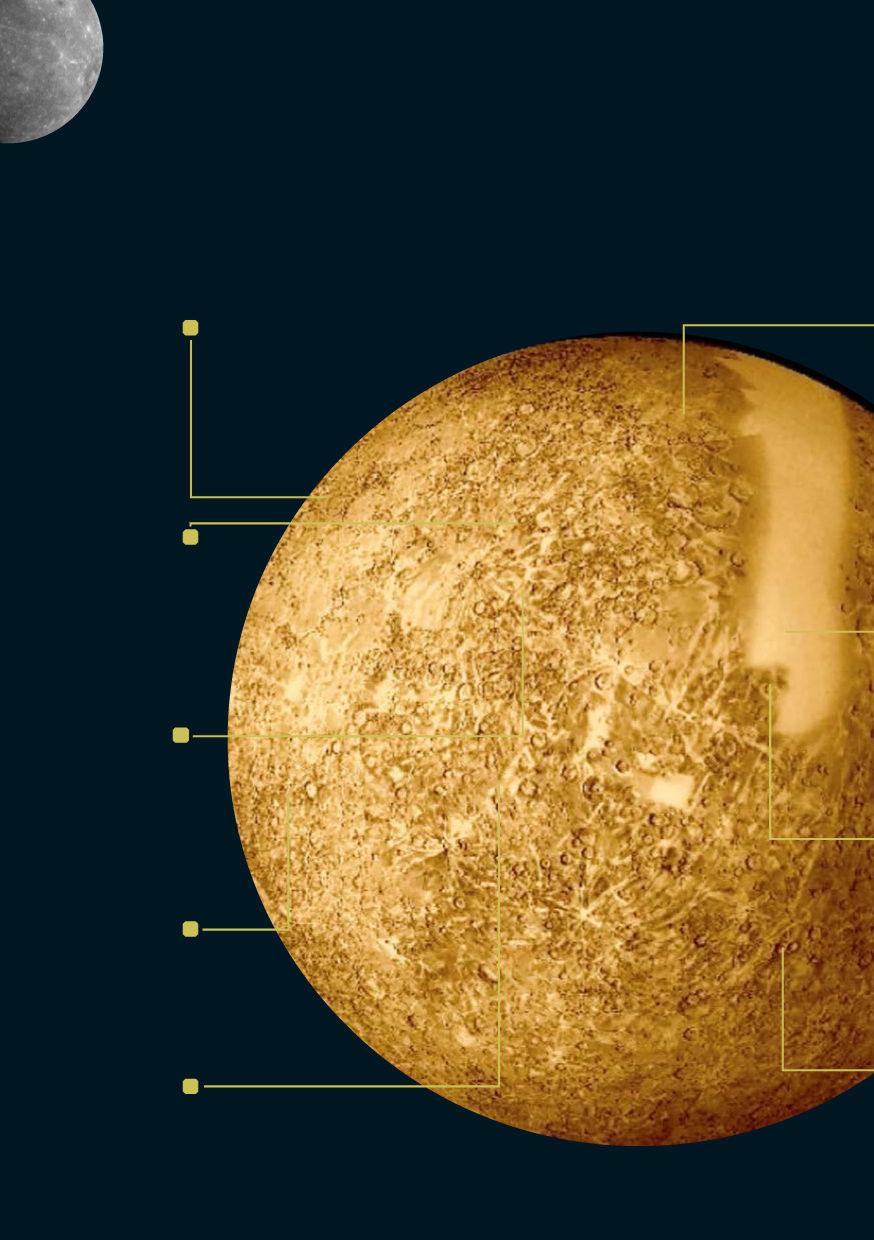
Sobkou Planitia
These plains contain several craters. Sobkou is the Egyptian messenger god
Budh Planitia This was an alternative name for Mercury. Budh is its official Hindu name
Tolstoj Basin
The impact that caused this crater occurred early in Mercury’s history
Bello Bello, named after a South American writer, is about 129km in diameter
Borealis Planitia This basin has a smooth floor and may be similar to the basaltic basins on Earth’s Moon
Blank area Mariner 10 was only able to map about 45% of Mercury’s surface (the night-time side) and missed a few areas
The Caloris Basin
This diagram shows how the large impact craters on Mercury’s surface – and particularly the Caloris Basin – have impacted the rest of the planet. At the antipode (a point on the other side of the planet exactly opposite of the basin), the ground is very uneven, grooved and hilly. It’s called the Chaotic Terrain because it stands out so much among the otherwise smooth plains. The terrain may have formed due to seismic waves or material actually ejected from the antipode.

The image of Mercury’s surface was taken at a distance of about 18,000km (11,100 mi)
Vivaldi A prominent crater at about 210km wide. Features a double ring
Fram Rupes This cliff was formed when the core cooled and contracted. It's named after the first ship reaching Antarctica
Mercury is a planet of extreme variations in temperature, in its surface features and in its magnetic field On the surface
The surface of Mercury is not very well understood, but mapping by Mariner 10 and Messenger has revealed numerous craters and plains regions, crisscrossed with compression folds and escarpments. Not long after it formed, the planet was hit heavily and often in at least two waves by large asteroids and comets, which caused its extremely cratered surface. Couple this with periods of strong volcanic activity, which resulted in the smooth plains, and you have a very hilly surface.
Mercury can reach 427 °C (800 °F), and there’s a big difference between the temperature at the equator and the temperature at its poles. It has the most temperature variations of any planet in the Solar System, getting as low as -183 °C (-297 °F). There may be deposits of minerals and ice within craters near the poles. The deepest
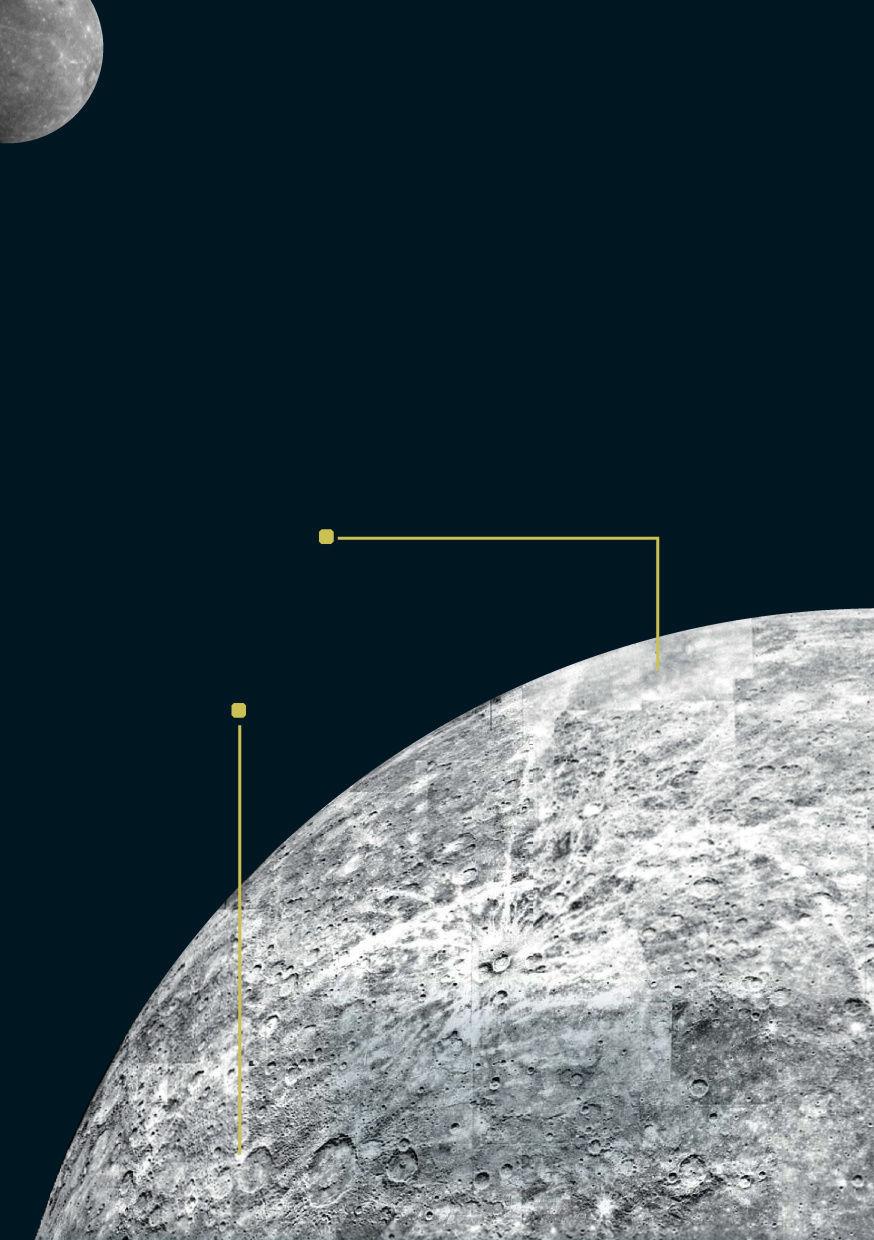
Pit-floor craters These craters are irregularly shaped and may be formed by the collapse of magma chambers below the surface
Impact craters
These craters can be hundreds of kms across, and can be fresh or very decayed
craters are located there, and are the most likely candidates to hold ice because they always stay shadowed, never rising above -17°C.
Because of its small size and wide changes in temperature, Mercury doesn’t have a true atmosphere. It has an unstable exosphere, a very loose, light layer of gases and other materials. Gases within it include helium, oxygen and hydrogen, some of which come from solar wind. Minerals such as calcium and potassium enter the exosphere when tiny meteors strike the surface and break up bits of rock. Mercury also has a magnetosphere, formed when the solar wind interacts with its magnetic field. Although that magnetic field is only about one per cent as strong as Earth’s, it traps in some
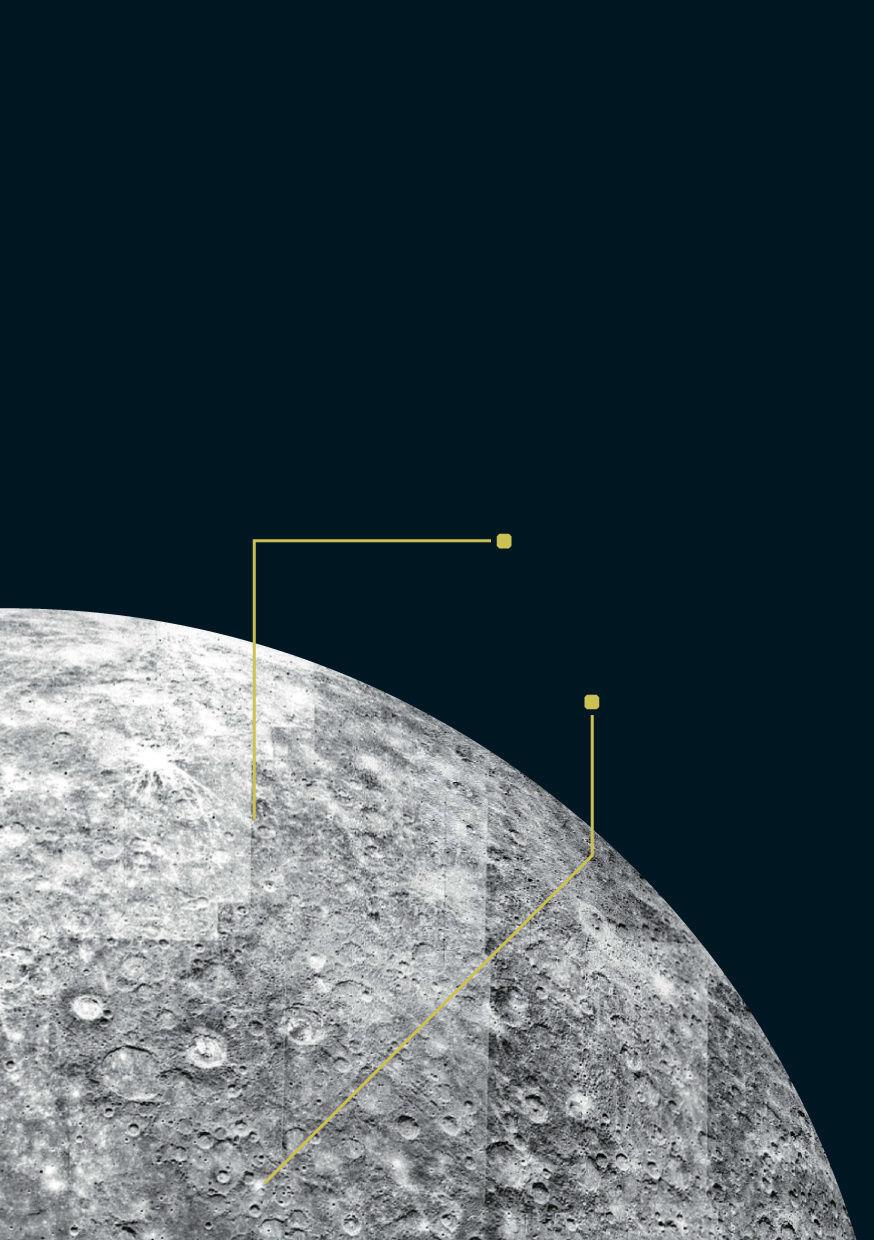
plasma from the solar wind, which adds to its surface weathering. The Messenger spacecraft discovered that Mercury’s magnetosphere is somewhat unstable, causing bundles of magnetic fields to be pulled out into space and wrapped into tornado-like structures by the passing solar wind. Some of these tornadoes are as long as 800km (497mi), about a third of the planet’s size. Before Mariner 10 flew by Mercury, it was thought not to have a magnetic field at all. The current theory is that it is caused by a dynamo, much like Earth’s magnetic field, which means that the planet has an outer core of electrically conducive, rotating molten iron. Not all scientists agree that Mercury is capable of generating a dynamo, however.
Plains There are both smooth and rolling or hilly plains, which may be the result of either volcanic activity or impacts
Scarps These steep cliffs can occur due to either erosion or compression within the planet’s interior
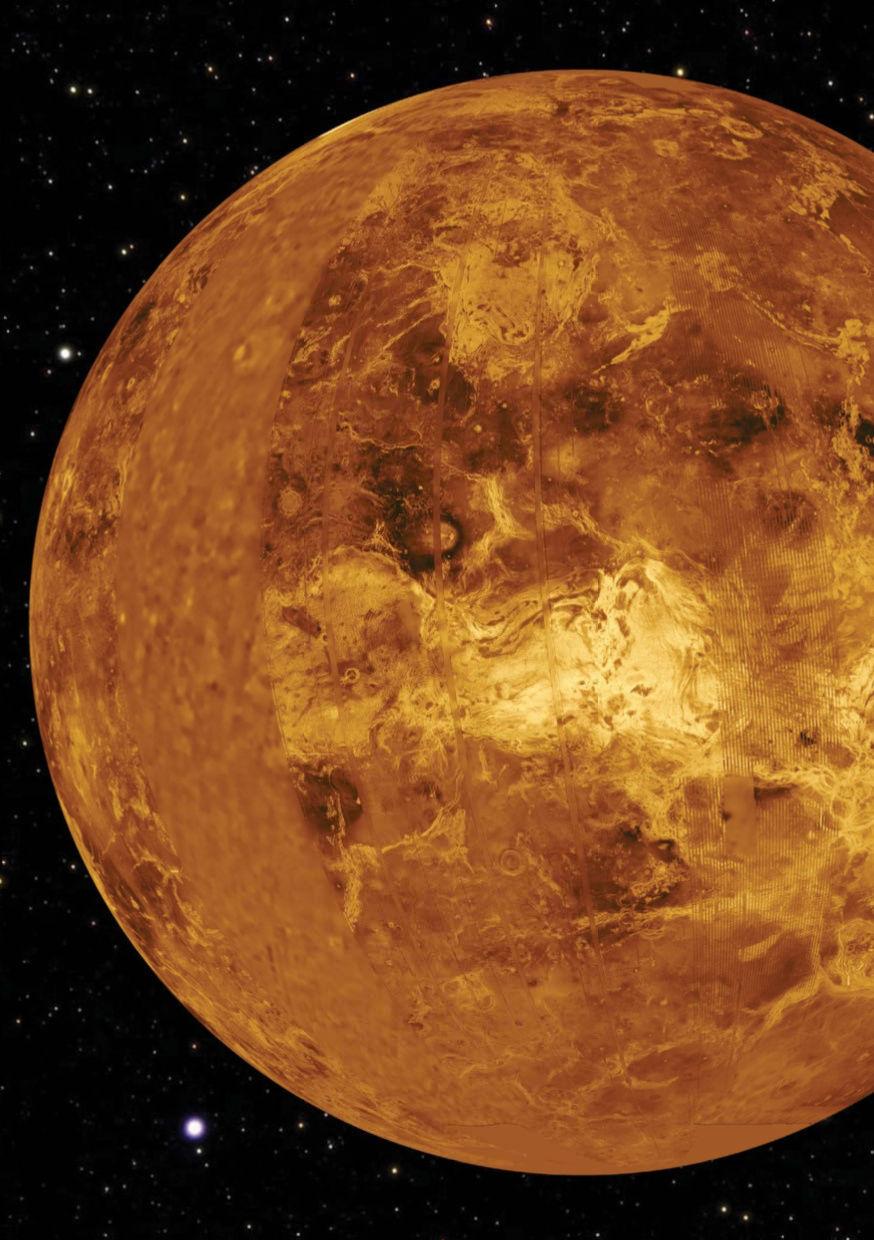
VENUS
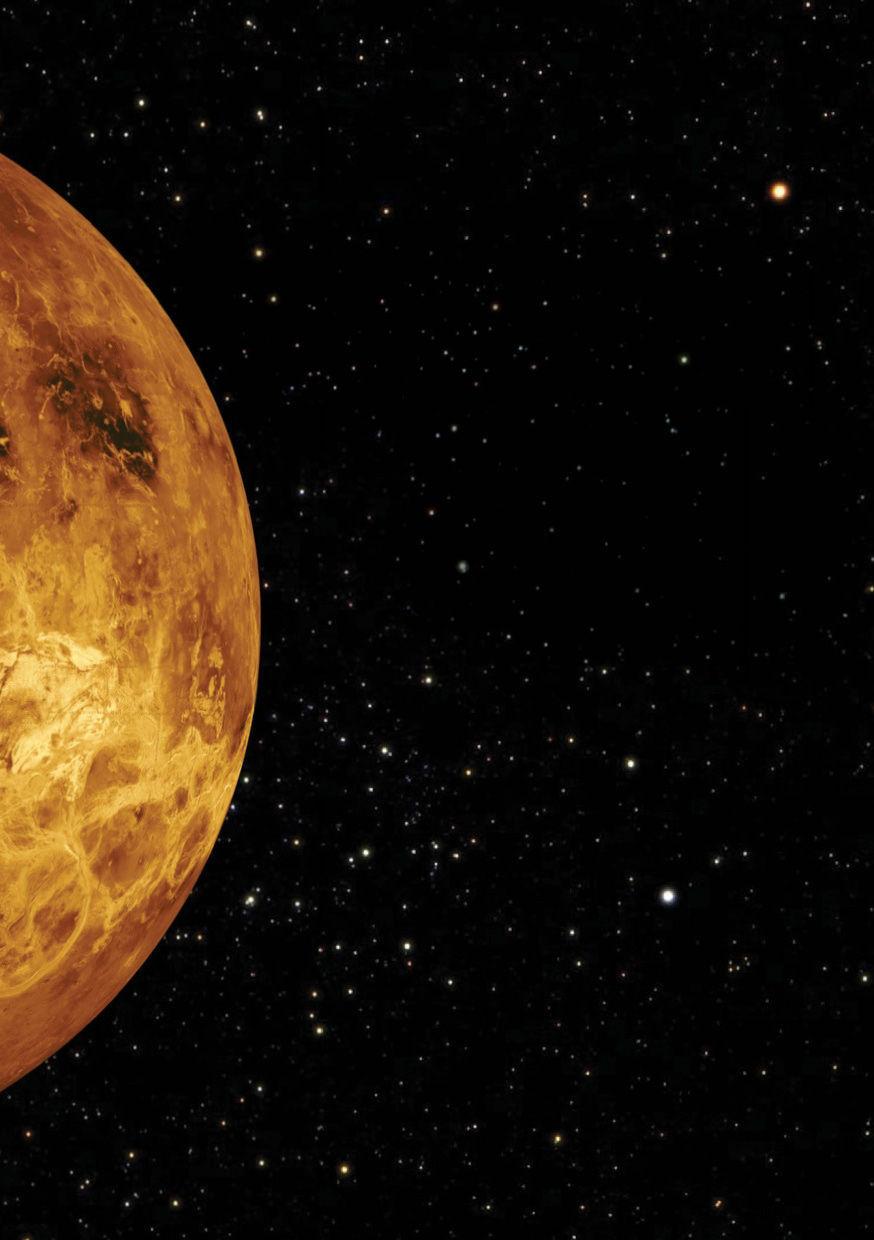
Venus is the most Earth-like planet in the Solar System, but there are a few key differences between the two planets, such as clouds of acid and temperatures hot enough to melt lead. Read on to discover more about Earth’s ‘evil twin’
Earth’s twin planet
Mass Venus has a mass that is about 81.5 per cent of Earth’s, at approximately 4.868 x 10 24 kilograms
Diameter Earth’s diameter is just 650 km greater than that of Venus – Earth’s is 12,742 km (7,918 mi). Venus’s is 12,092 km (7,514 mi)
Surface Both planets have relatively young surfaces, without many craters
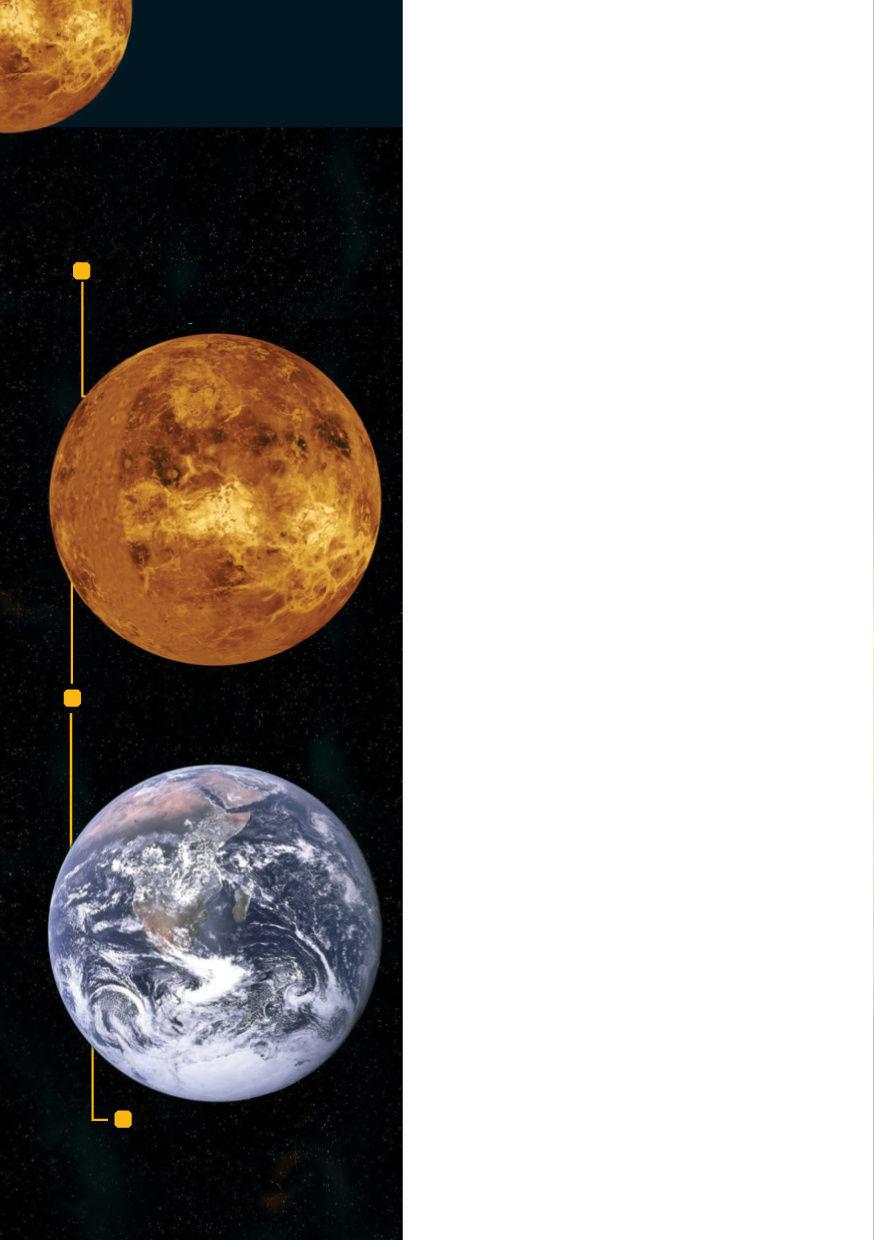
Venus, named after the Roman goddess of love and beauty, is a study in contradictions. It was likely first observed by the Mayans around 650 AD, helping them to create a very accurate calendar. It’s well-known to us because of its apparent magnitude, or brightness, in our sky – the second-brightest after our own Moon. It’s most visible at sunrise and sunset, and like Mercury was thought of as two different planets by the Ancient Egyptians – Morning Star and Evening Star. It’s the secondclosest planet to the Sun, the closest to Earth, and the sixth-biggest planet in the Solar System.
Venus is often described as the Earth’s ‘twin’ or ‘sister planet’. Like Earth, Venus is a rocky planet, with a mass that’s 81.5 per cent of the Earth’s mass. It’s 12,092 km (7,514 mi) in diameter, which is just 650 km (404 mi) shy of Earth’s diameter. Both planets have relatively young surfaces, with few craters. But that’s where the similarities end. Venus has been called possibly one of the most inhospitable planets in the Solar System, because lurking beneath its dense cloud cover is an atmosphere that’s anything but Earth-like, which is why some astronomers have taken to calling it Earth’s ‘evil twin’ instead.
Of all the planets, Venus has the most circular orbit, with an eccentricity (deviation from a perfect circle) of 0.68 per cent. By comparison, the Earth has an eccentricity of 1.67 per cent. Venus comes within 108 million km (67 million mi) of the Sun on average. When it happens to lie between the Sun and the Earth – which occurs every 584 days – it comes closer to the Earth than any other planet. Around 38 million km (24 million mi) close, that is. Because Venus’s orbit around the Sun passes inside the Earth’s orbit, it also goes through phases that go from new to full and back to new again. These phases are the different variations of light emanating from it as seen from the Earth, much like the Moon’s phases. When Venus is new (not visible) it is directly between the Earth and the Sun. At full, it is on the opposite side of the Earth from the Sun. These phases were first recorded by Galileo in 1610.
The rarest of predictable events in our Solar System involve Venus. Known as transits of
The transit of Venus
In-between A transit occurs when Venus passes directly between the Sun and Earth, becoming visible against the solar disc
Time taken
The duration of such a transit is usually measured in hours. The transit of 2012 lasted six hours and 40 minutes
Black disc In this composite image from the June 2012 transition, Venus can be seen as a small black disc moving across the face of the Sun

Rare sight The next transits of Venus will take place in 2117 and 2125
Venus’s orbit
Quarter phase Much like the Moon, Venus has two half-lit phases called quarters
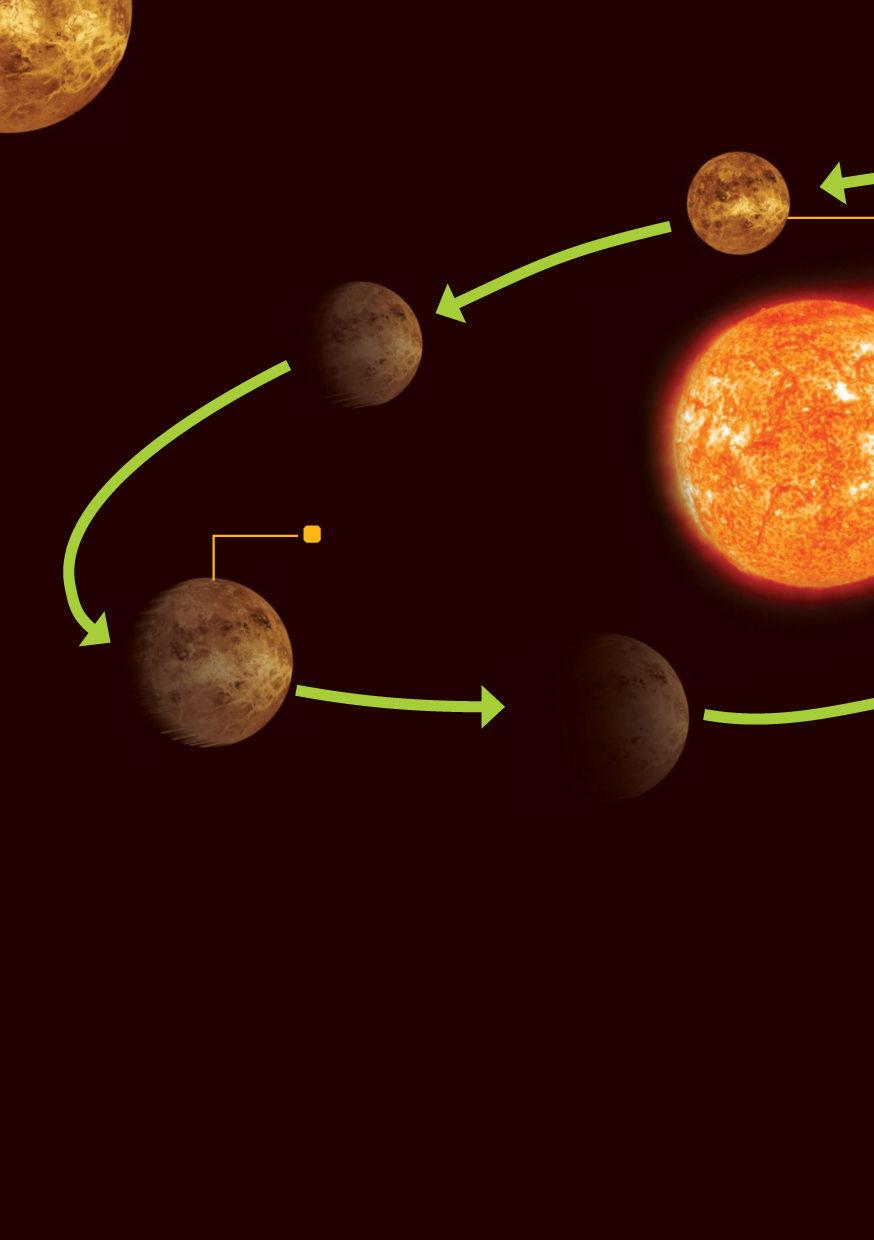
Venus, this only happens once every 243 years in a pattern. A transit is somewhat like a solar eclipse, occurring when the planet is between the Earth and the Sun. Transits of Venus happen eight years apart, then with gaps of 105.5 years and 121.5 years between them.
The odd pattern has to do with the relationship between the orbital periods of the two planets. Usually they happen in pairs, but not always. During a transit, Venus looks like a tiny black disc passing across the Sun’s surface. The first modern observation of a transit of Venus occurred in 1639, while the most recent was on 5 and 6 June 2012. The transits have always provided astronomers with lots of information about not only Venus, but our Solar System. The earliest helped gauge the size of the Solar System itself, while the one in 2012 is hoped to help us find planets outside our Solar System, or exoplanets.
What else sets Venus apart from the other planets in the Solar System? Its retrograde rotation. Every planet orbits the Sun anti
Full When Venus is full, we can’t actually see it from Earth because the Sun unfortunately blocks our view
Gibbous As it wanes and waxes, we can see about 75 per cent of the planet. It looks larger when waning as it moves closer to Earth
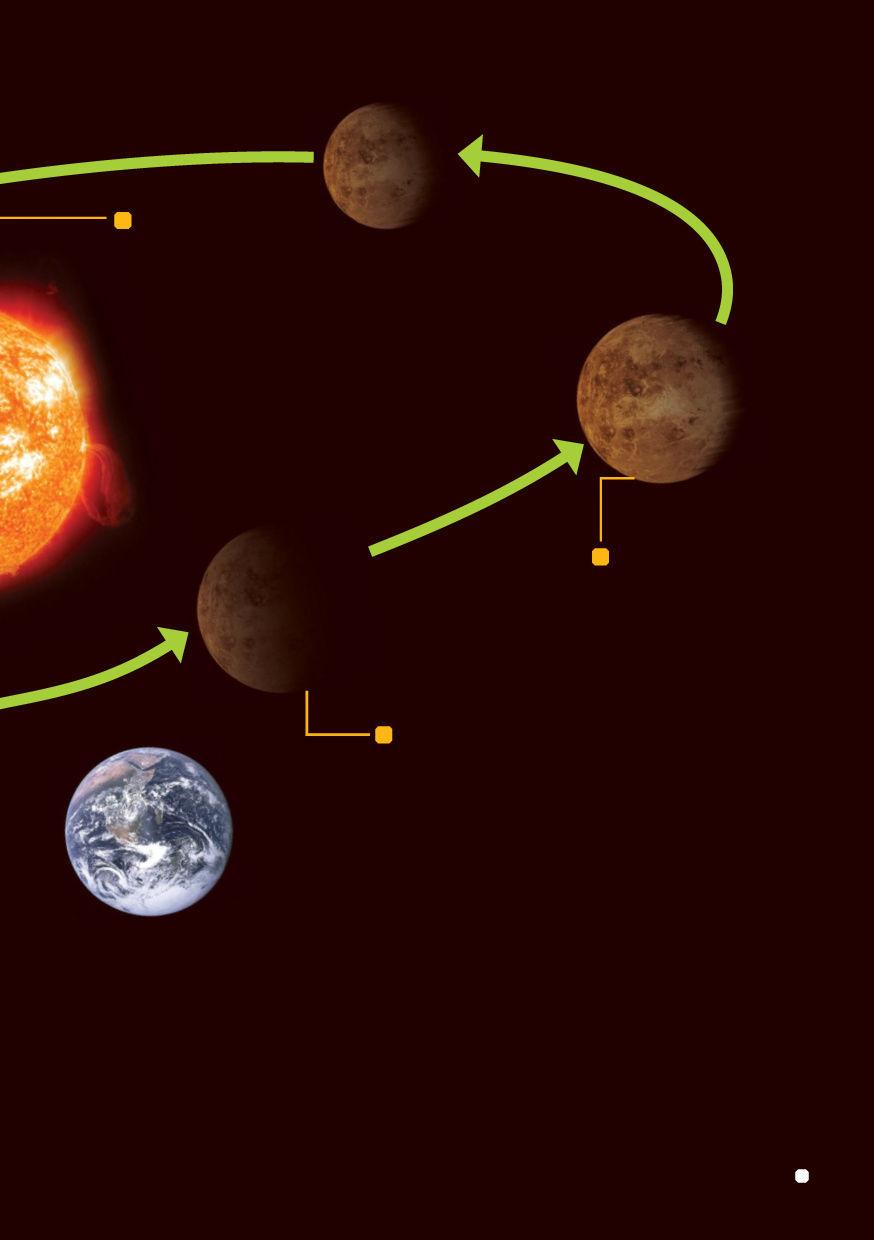
Crescent People with really precise eyesight can sometimes observe the crescent phase, but typically you will need a telescope
clockwise, and most of them rotate anticlockwise, too. But Venus rotates clockwise, making a Venusian sidereal day last about 243 Earth days – incidentally one of the slowest rotations of any planet that we know of. But its orbit around the Sun lasts 224.7 days, making Venus’s days longer than its years. All of this means that if you were standing on the surface of the planet, you’d see the Sun rise in the west and set in the east, but only every 116.75 Earth days or so.
Many astronomers have wondered why Venus has such a circular orbit and unusual rotation. All planets came from the solar nebula – matter left over from the formation of the Sun – but maybe Venus had a more violent beginning. One theory is that it formed from the collision of two smaller planets, which impacted at such high speeds that they simply fused together, leaving little debris. Another is that the planet experienced other multiple impact events – and even had one or more moons – that caused its spin to reverse.






